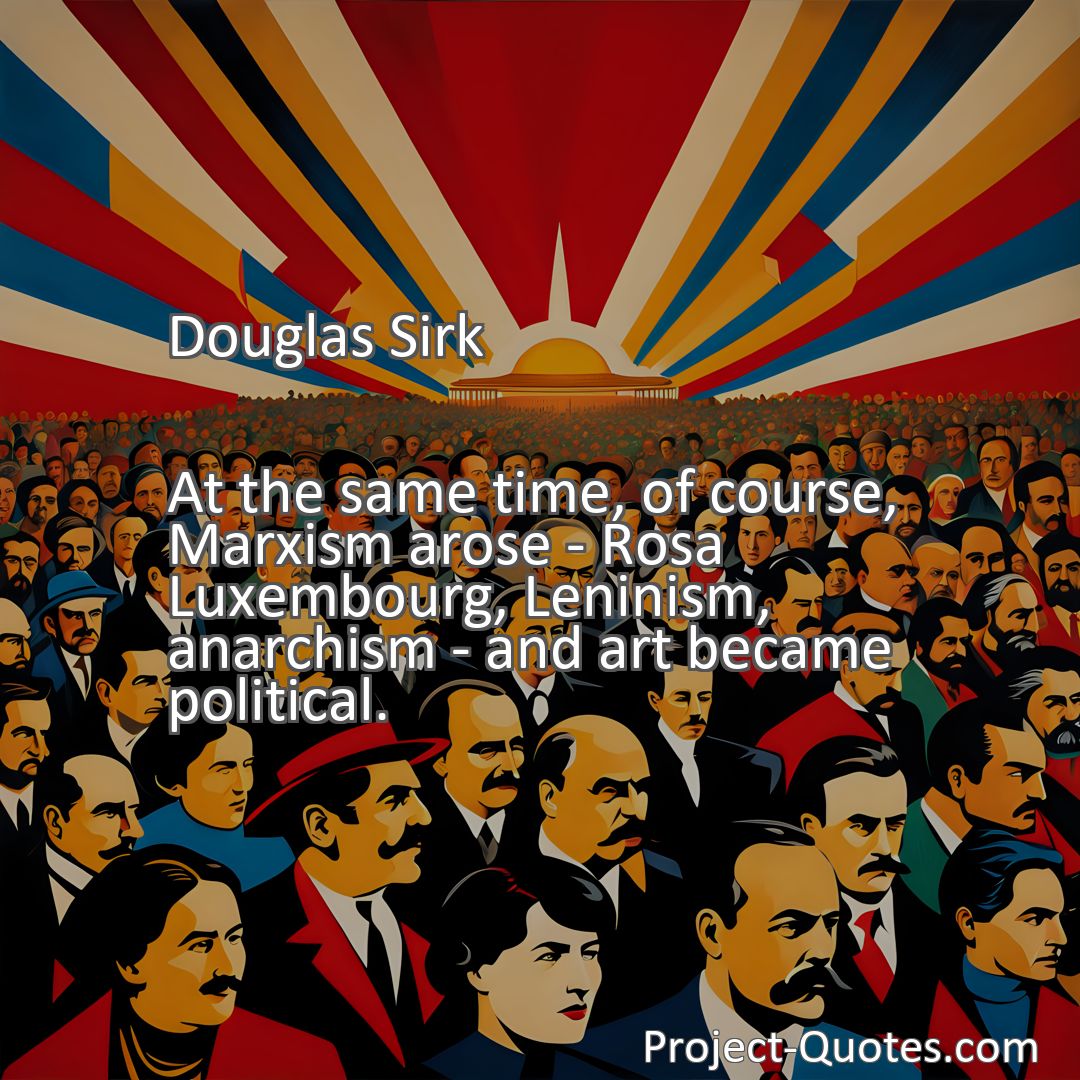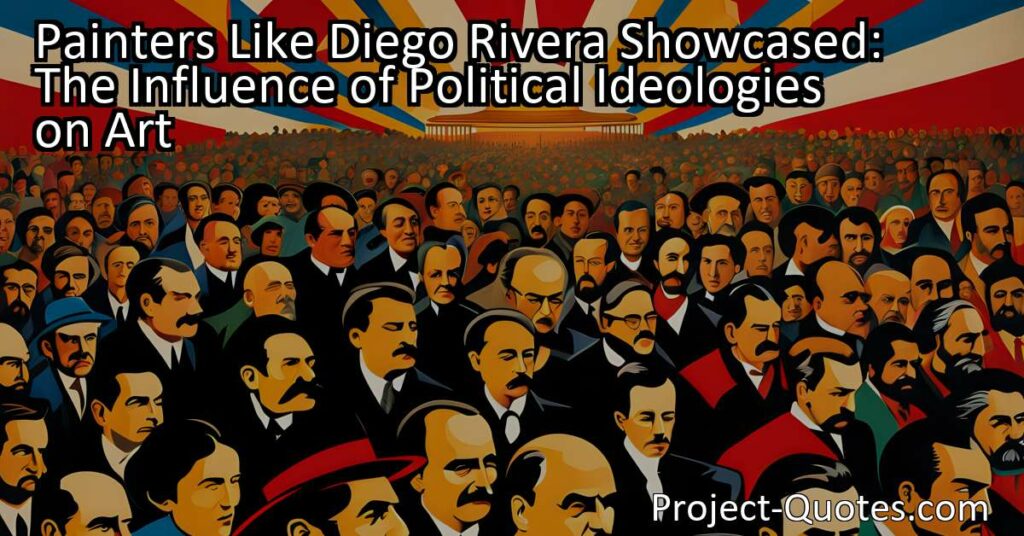At the same time, of course, Marxism arose – Rosa Luxembourg, Leninism, anarchism – and art became political.
Douglas Sirk
Painters Like Diego Rivera Showcased: The Influence of Political Ideologies on Art In the world of art, political ideologies like Marxism, Leninism, and anarchism had a profound impact on artists and their work. From writers and painters to theater groups and filmmakers, these ideologies inspired artists to express their discontent, challenge societal norms, and advocate for social and political change. Painters like Diego Rivera used their powerful murals to showcase the struggles of the working class, while figures like Douglas Sirk incorporated political undertones into their films, highlighting the interconnectedness between personal and political realms.
Table of Contents
Meaning of Quote – At the same time, of course, Marxism arose – Rosa Luxembourg, Leninism, anarchism – and art became political.
Art has long been a reflection of society, giving voice to the thoughts, opinions, and emotions of individuals. It has the power to transcend time and space, leaving a lasting impact on both its creators and audience. Over the course of history, various movements and ideologies have shaped the way art is perceived and created. One such pivotal period was the rise of political ideologies such as Marxism, Leninism, and anarchism, which greatly influenced the world of art.
As expressed by the influential filmmaker Douglas Sirk, “At the same time, of course, Marxism arose – Rosa Luxembourg, Leninism, anarchism – and art became political.” These words hold a profound significance as they highlight the intersection between politics and art, and the transformative effect it had on the creative world. Sirk’s observation takes us back to a time of ideological upheaval, where these political philosophies emerged and left an indelible mark on various art forms.
Marxism, for instance, introduced the idea of the class struggle, emphasizing the division between the proletariat and the bourgeoisie. This concept found its way into literature, painting, and even theater during the early 20th century. Writers such as Maxim Gorky and Upton Sinclair wrote works that portrayed the struggles of the working class, shedding light on their exploitation and advocating for social change. Painters like Diego Rivera showcased the plight of the workers through their powerful murals, and theater groups performed plays that openly criticized the capitalist system.
Similarly, Leninism, named after the Russian revolutionary Vladimir Lenin, had a profound impact on art as well. This movement of thought centered around the idea of a vanguard party, leading the proletariat in a revolution against the ruling class. It aimed to create a society based on socialist principles, where the means of production were owned and controlled by the working class. As the world transformed politically, art followed suit, reflecting the revolutionary spirit of Leninism. Artists like Kazimir Malevich and El Lissitzky embraced the geometric abstraction movement known as suprematism, using bold shapes and colors to portray a new utopian vision. The Constructivist movement also gained prominence, advocating for the fusion of art and everyday life, rejecting bourgeois values and emphasizing collective effort.
Alongside these political movements, anarchism also emerged as a potent force. Anarchists rejected all forms of government and advocated for a stateless society based on voluntary cooperation. This ideology found its way into various artistic expressions, challenging societal norms and established institutions. Writers like Emma Goldman and Pierre-Joseph Proudhon penned powerful essays and manifestos that critiqued the oppressive nature of authority. Visual artists like Gustav Courbet and Félix Vallotton used their brushstrokes to challenge the existing power structures and to inspire individuals to question the status quo.
Art became a powerful tool for political discourse during this time, as it offered a platform for artists to express their discontent and desire for change. It provided an outlet for marginalized voices, allowing them to be heard and seen. Artists embraced their role as catalysts for social and political transformation, using their creative endeavors to provoke thought, inspire action, and challenge the prevailing systems of power.
However, the emergence of politically-oriented art was not without controversy. Critics argued that art should be autonomous and concerned solely with aesthetics, fearing that its fusion into politics would compromise its artistic integrity. They believed that art should be purely decorative or emotionally driven, devoid of any social or political agenda. Despite these criticisms, the politically charged art movements continued to thrive, finding resonance with a growing number of individuals who saw art as a means to effect meaningful change.
The impact of political ideologies on art during this time was not limited to specific mediums or artistic disciplines. It extended to the realm of cinema as well. One influential figure in this domain was Douglas Sirk, the author of the quote. Sirk was a German-born American film director known for his melodramatic films. His works explored social and political issues, often challenging established norms and conventions. Through his films, Sirk delved deep into the complexities of human relationships and societal structures, skillfully weaving political undertones into his narratives. He used the medium of cinema to reflect the aspirations and struggles of individuals in a changing world, highlighting the interconnectedness between personal and political realms.
In conclusion, the rise of political ideologies such as Marxism, Leninism, and anarchism greatly influenced the art world. Artists embraced their role as agents of change and used their craft to provoke thought and challenge societal norms. These ideologies provided a lens through which artists expressed their discontent and desire for social transformation. While critics questioned the merging of politics and art, the politically-oriented movements continued to thrive, leaving a lasting impact on literature, painting, theater, and cinema. Figures like Douglas Sirk embodied this spirit, using their creative expressions to navigate the complexities of the human condition and illuminate the profound relationship between art and politics.
I hope this quote inspired image brings you hope and peace. Share it with someone who needs it today!


